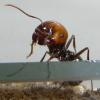Hi my Camponotus brasiliensis colony that is around 5 years old started to produce winged males but not winged females.
The Queen is still alive and also some new regular worker females appear.
This behavior is now longer than a year, that is why the Queen must still be alive because if not all the female worker must already be dead because the only live up to 6 months.
The winged males just walk around stupidly and maybe 1% actually manages to fly (thankfully because my formicarium is open)
The growth of the colony is stuck, I even think it is slowly getting slower. That is why I made a big effort to find the queen (as the major workers are almost as big as the queen, it was hard but i could find her and recognize the scars from where the wings were). I read that some ant species produce sterile winged males when the queen dies (apparently the females can produce real eggs where winged males hatch without being fertilizes by a male)
I did not really change the environment ( always heated room temp 20 - 25°C and in winter low humidity because of the heating )
My Question:
Has anyone experienced this behavior and if yes how could you stop it ?
For me my first guess would be that the colony is "stuck" in a bad reproductive cycle. That means naturally in nature at a specific time of the year ( based on the environment parameters such as humidity, temperature, daily hours of sunlight etc...) the normally produce winged males and female that then swarm when the conditions are right and after this the colony goes back to "normal" which means producing female workers.














